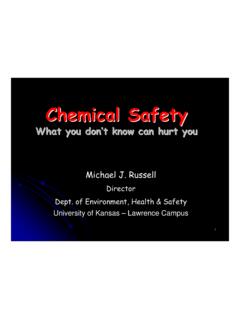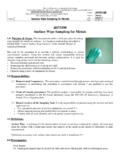Transcription of (ATOMIC ABSORPTION) Method Number: ID-121 OSHA …
1 metal & METALLOID PARTICULATES IN WORKPLACE ATMOSPHERES (ATOMIC ABSORPTION) Method Number: ID-121 Matrix: Air, Wipes, or Bulks OSHA permissible Exposure limits : See Table 1 Collection Procedure: Personal air samples are collected on mixed-cellulose ester filters using a calibrated sampling pump. Wipe or bulk samples are collected using grab sampling techniques.
2 Recommended Sampling Rate: 2 L/min Recommended Air Volumes Time Weighted Average Samples: 480 to 960 L Short-Term Exposure Limit Samples: 30 L Ceiling Samples: 10 L* Analytical Procedure: Samples are desorbed or digested using water extractions or mineral acid digestions. Elemental analysis of the prepared sample solutions is performed by atomic absorption or emission spectroscopy. Detection limits : See Table 2 Precision and Accuracy: See Table 3 Method Classification: Validated Analytical Method Date: 1985 Date Revised: February 2002 * Alternate air volumes may be necessary to achieve good analytical sensitivity.
3 Commercial manufacturers and products mentioned in this Method are for descriptive use only and do not constitute endorsements by USDOL-OSHA. Similar products from other sources can be substituted. Division of Physical Measurements and Inorganic Analyses OSHA Technical Center Salt Lake City, Utah 1 of 25 T-ID121-FV-02-0202-M 1.
4 Introduction This Method can determine the amount of specific metal and metalloid particulates in the workplace atmosphere. The airborne particulates are collected on filters using calibrated sampling pumps. These samples are then analyzed using flame atomic absorption or emission spectrometry. This Method can also determine specific metals and metalloids contained in wipe and bulk samples. The identification and quantification of the particulate is directly determined as the element. The elements are: Aluminum (Al) Silver (Ag) Lithium (Li) Cobalt (Co) Gold (Au) Bismuth (Bi) Thallium (Tl) Molybdenum (Mo) Potassium (K) Iron (Fe) Cesium (Cs) Yttrium (Y) Antimony (Sb) Sodium (Na) Magnesium (Mg) Copper (Cu) Hafnium (Hf) Cadmium (Cd) Tin (Sn) Nickel (Ni) Selenium (Se) Lead (Pb) Chromium (Cr) Zinc (Zn) Barium (Ba) Tellurium (Te) Manganese (Mn) Platinum (Pt) Indium (In) Calcium (Ca) Titanium (Ti) Zirconium (Zr) For some analytes, there are alternate methods or procedures which may be more sensitive, accurate, or specific.
5 When a separate OSHA Method or procedure exists, that Method shall take precedence over this Method unless special circumstances render it inapplicable. Elements or compounds having alternate methods or stopgap procedures are: Element or Compound OSHA Method No. Aluminum oxide ID-198SG or ID-109SG Barium sulfate ID-204 Cadmium ID-189 Chromic acid/chromates ID-103 Ferrovanadium ID-125G Vapors ( Ni(CO)4, H2Se, TeF6, C5H4Mn(CO)3] In-House Methods Organic tin compounds ID-102SG Platinum (soluble) ID-130SG Selenium ID-133SG Solders ID-206 Stibine NIOSH 6008, In House Tetraethyl lead and tetramethyl lead In-House Method Titanium dioxide ID-204 Welding fumes ID-125G Zinc oxide ID-143 Depending on advances in technology or changes in exposure limits , substances may be added or deleted from the above lists.)
6 History Air and wipe samples containing metal and metalloid particulate have always been analyzed at the OSHA Salt Lake City Analytical Laboratory using atomic absorption or emission spectrometry ( ). Constituents in bulk samples have been determined semi-quantitatively using this technique. Principle Air samples of the workplace are taken using calibrated sampling pumps with cassettes containing either mixed cellulose ester (MCE) or polyvinyl chloride (PVC) filters. These samples are prepared in the laboratory using concentrated (concd) acids or extracted with deionized water if a soluble fraction is required.
7 The sample solution is diluted to a known volume after any necessary matrix modifiers are added. The sample is then aspirated into the flame of an atomic absorption or emission spectrophotometer (AAS or AES) and the molecules in the sample solution are subjected to the following processes: 2 of 25 T-ID121-FV-02-0202-M
8 1) nebulization 2) desolvation 3) liquefaction 4) vaporization 5) atomization 6) excitation (atoms converted from "ground" to excited state) 7) ionization The absorption or emission of light occurring during processes 5 and 6 is then measured at the characteristic wavelength for the element of interest. For absorption, a hollow cathode lamp or an electrodeless discharge lamp (EDL) is used as the light source. A double beam spectrophotometer is normally used where the lamp radiation alternately passes through and around a flame into which the sample is being aspirated.
9 The sample is atomized and the metal or metalloid atoms absorb light from the source at their characteristic wavelengths. This absorption is proportional to the concentration of the element present in the sample solution. A monochromator isolates the characteristic radiation of the element being analyzed. A photosensitive device then measures the intensity of the transmitted radiation from the two light paths to determine the amount of absorbance occurring in the flame. For emission, a light source is not used. The sample is introduced into the flame, atomized and excited, and then the light emission from excitation is isolated and measured.
10 The intensity of the light emitted is proportional to the concentration of the element present. The following flames are used in this Method for absorption or emission: a) Air/Acetylene mixture (Air/C2H2) b) Nitrous oxide/Acetylene mixture (N2O/C2H2) c) Air/Hydrogen mixture (Air/H2) The use of a specific flame is dependent on the respective element's analytical stability, sensitivity, and interferences. Advantages and Disadvantages This analytical Method is specific for the element to be determined and does not distinguish different compounds. When an analysis for a compound is requested, an elemental analysis is performed on the sample.















